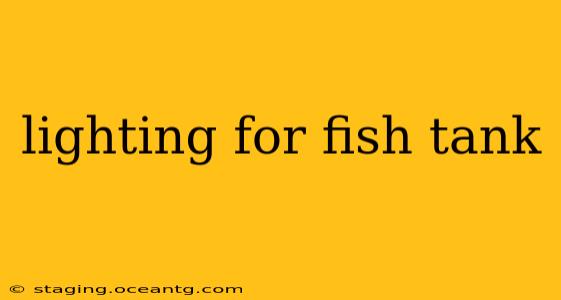Choosing the right lighting for your fish tank is crucial for the health and happiness of your aquatic inhabitants, as well as the overall aesthetic appeal of your aquarium. More than just a pretty glow, proper lighting supports vital biological processes within your tank, influencing plant growth, fish behavior, and the prevention of algae blooms. This comprehensive guide explores everything you need to know about selecting, installing, and maintaining the perfect lighting for your fish tank.
What are the different types of fish tank lights?
There's a wide array of fish tank lighting options available, each with its own strengths and weaknesses. Let's break down the most common types:
-
Fluorescent Lights: These are a classic choice, offering good light penetration and a relatively long lifespan. They're energy-efficient and come in various color temperatures, allowing you to tailor the light spectrum to your specific needs (e.g., promoting plant growth or enhancing fish coloration). However, they can be less aesthetically pleasing than some newer options.
-
LED Lights: LEDs are rapidly becoming the most popular choice due to their energy efficiency, long lifespan, low heat output, and diverse color options. They offer excellent color rendering and can be easily customized with different color spectrums and intensities. Moreover, LED lighting systems often come with advanced features like timers and dimming capabilities.
-
Metal Halide Lights: These lights provide intense illumination, making them ideal for larger tanks and planted aquariums requiring high light intensity. However, they generate significant heat, consume more energy, and have a shorter lifespan compared to LEDs. They also require specialized ballasts.
-
T5 and T8 Fluorescent Tubes: These are variations of fluorescent lighting. T5 tubes are slimmer and more energy-efficient than T8s but generally require a more complex fixture.
How many hours of light should my fish tank have?
The ideal lighting duration depends on several factors, including the type of fish and plants in your tank, the intensity of the light, and the tank's size and placement. Generally, a photoperiod of 8-10 hours per day is recommended for most setups. Longer periods can promote excessive algae growth, while shorter periods might not adequately support plant growth or fish health. Always research the specific light requirements of your fish and plants before setting a schedule.
What is the best light spectrum for a fish tank?
The best light spectrum depends on your tank's inhabitants and your goals. For planted tanks, a full-spectrum light with a good balance of red and blue wavelengths is crucial for photosynthesis. Red light promotes stem growth, while blue light encourages leaf growth and vibrant colors. For fish-only tanks, a warmer light spectrum can enhance their natural coloration. Many modern LEDs offer customizable color settings, allowing you to fine-tune the spectrum to your exact preferences.
How do I prevent algae growth in my fish tank?
Excessive algae is a common problem associated with improper lighting. To prevent algae blooms, ensure you're using the appropriate light intensity and duration for your setup. Regular water changes, proper filtration, and controlling nutrient levels are equally important. Consider using algae-eating fish or snails as a natural form of algae control. If algae still becomes problematic, you may need to adjust your lighting schedule or intensity.
How much light does a planted aquarium need?
Planted aquariums require significantly more light than non-planted tanks. The amount of light depends on the plant species—some low-light plants can thrive with minimal illumination, while others need intense light to flourish. High-light plants often require supplemental CO2 injection to maximize their growth potential. Always research the light requirements of each plant species before adding them to your tank.
What is PAR in aquarium lighting?
PAR (Photosynthetically Active Radiation) measures the amount of light available for photosynthesis. It's a crucial factor in planted aquariums. Higher PAR values indicate more light available for plant growth. However, excessive PAR can lead to algae problems, so finding the optimal PAR level for your specific setup is vital. Measuring PAR with a PAR meter ensures you provide the correct light intensity for your plants.
By understanding the various types of lighting, their benefits and drawbacks, and the specific needs of your aquatic ecosystem, you can create a thriving underwater world that's both healthy and beautiful. Remember, careful planning and research are key to successfully illuminating your fish tank.
